
Body piercing,
tattooing,
painting
in the galleries
of the
Penn Museum.
|
Painful
as it might feel, the
practice of piercing a hole through the skin and inserting a
piece of metal, bone, shell, ivory or glass to wear as an ornament
has been around for millennia. Body piercing occurs worldwide
and is practiced on men, women and children. It's grown in popularity
during the past five years, especially among American teenagers,
who pierce just about anything that can be pierced: ears, noses,
tongues, and navels.
|
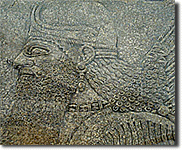
Male with pierced
ear,
Iraq,
9th century B.C.
|
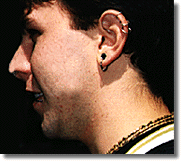
Male
with multiple ear piercings,
suburban Philadelphia, 1998
|
|
The most
conventional form of piercing in the United States today is
ear piercing. Among young and old, male and female, ear piercing
is common practice and has become more mainstream for both sexes
than it once was. Ear piercing can range anywhere from a single
hole in one or both ears to holes along the entire rim of the
ear. While currently trendy, multiple piercings are nothing
new: the Museum's Near
Eastern gallery displays a 4000 year-old clay figurine with
multiple-pierced ears!
|
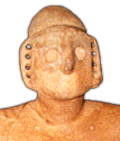
Head of female
figurine
with holes for multiple ear piercings
Iran,
3500-2900 B.C.
|

Gold earrings,
Cyprus, Late 4th-2nd century B.C.
|
Our reasons
for piercing our bodies can change over time, and may vary from
culture to culture. For example, a pair of gold earrings (left)
from the Museum's Ancient
Greek World gallery can tell us that the people living on
the island of Cyprus 2200 years ago pierced their ears. But
this evidence can also raise questions: Were earrings worn by
both men and women then? Why did these ancient people wear gold
bulls as adornment? Archaeologists and anthropologists are always
seeking answers to questions like these.
|
|
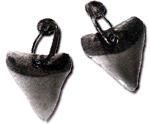
Tlingit shark
tooth earrings with silver catches,
Alaska,
1918
|
Among the
Tlingit of southeast Alaska, we know that ear piercing was directly
related to an individual's rank in society. Social position
was determined by the wealth of the family into which the individual
was born. Although a Tlingit could rarely better his own social
standing, he could raise the station of his sister's children
and his grandchildren by "potlatching" (hosting a community
feast). At a potlatch the host paid a member of his moiety (group)
to pierce the rims of the children's ears. At additional potlatches,
other holes were added. A great amount of wealth was required
to host the feast and pay the person to pierce the children's
ears. Consequently, the resulting series of holes marked an
individual as a member of the nobility.
|
|
The latest alternative
piercing trend in some American cities involves stretching earlobes
in order to accommodate ear-spools and earplugs. The spools
and plugs of today have an amazing resemblance to those worn by
the people of ancient Mexico, including the Maya. The spools and
plugs pictured at the right are on display in the Museum's Mesoamerican
gallery. Carved from obsidian (a volcanic glass), they range
in size from approximately one centimeter to an inch in diameter.
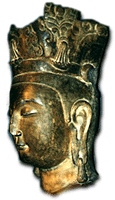
Stone head
of a Bodhisattva with pierced ears and stretched lobes,
China,
A.D. 550-577
Museum Object Number: C444
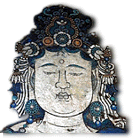
Detail of
Chinese wall mural showing a woman
with pierced ears and stretched lobes, China,
A.D. 1368-1644
Museum Object Number: C688
|
Throughout
Asia, we can also find examples of stretched earlobes
that come from wearing extremely heavy earrings. This statue
from the Museum's Buddhism
gallery (left) is a good example
of stretched earlobes.
Other
evidence of stretched lobes can be seen in details from a
wall mural displayed in the Museum's Chinese
Rotunda. This woman (left) has
earrings in her ears, and you can see that her earlobes are
stretched from the weight of the earrings. This practice can
still be seen on the modern Asiatic island of Borneo (see
woman, right).
|
|
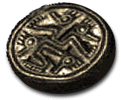

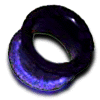
Earplug and ear-spools,
Guatemala,
A.D. 900-1500
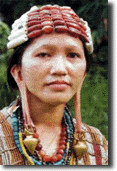
A woman with pierced
ears and stretched lobes, Borneo,
1988
|
|
Less mainstream
in our society than ear piercing, but becoming more popular, is
lip piercing. Looking at a person with a pierced lip may
make others wonder, "Doesn't that thing click against the teeth?"
|
Until
the late 19th century, the Eskimo of Alaska defined
social status among groups by lip piercing. Both men and women
wore lip-plugs, called labrets, such as this ivory one (below)
from the Museum's Native
Alaska gallery.
|

Labret,
Point Barrow, Alaska,
1897
|
|
Doug
with nose, lip, and tongue piercings, suburban
Philadelphia, 1998
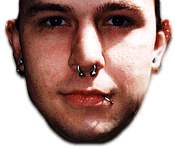
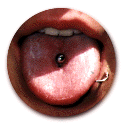
|
|
An Eskimo man
wore either one lip-plug (worn centered to his mouth) or two (worn
on either side of his mouth). A man wearing the double labrets resembled
a walrus, like this figure (right) displayed
in the Museum's Native
Alaska gallery. Young men received the labret as a type of initiation.
Since holes for their labrets were often cut when they reached puberty,
a lip-plug symbolized that an Eskimo boy had entered manhood. Eskimo
women usually wore only one central lip-plug as decoration; however,
the highborn Tlingit girls wore a labret to indicate their noble
social status.
Eskimo men and
women increased the size of their lip-plugs by gradually stretching
the hole in the lip. Often labrets were so large that their lips
hung down, exposing teeth and gums. Larger labrets sometimes interfered
with speaking and eating and had to be removed.
|
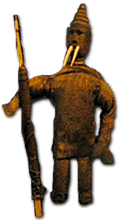
Walrus-Man figure wearing double labrets,
Point Barrow, Alaska,
1897
|
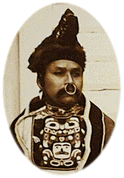
Man with nose ring,
Alaska,
late 19th century
|
Another popular
kind of piercing today in American culture is nose piercing.
Nose rings can be worn on either side of the nose or through the
septum (middle). Among the Tlingit of southeast Alaska, nose rings
were considered a mark of distinction and prestige and were worn
by both men and women. Nose piercing was also popular in Ancient
Mexico and India. Today, women in India and Pakistan continue to
wear nose rings, as do many other people around the world.
|
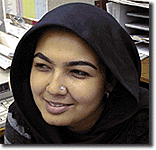
Uzma and her nose ring, Philadelphia,
1998
The
next time you see someone with a nose piercing, try to note which
side of the nose it's on: the position means different things to
different people.
|
|

